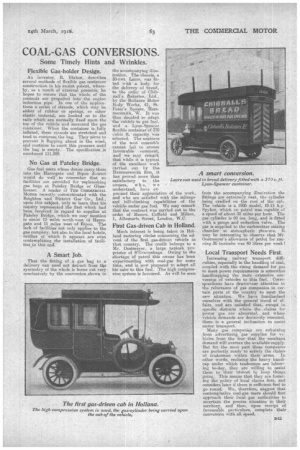COAL-GAS CONVERSIONS.
Page 19

If you've noticed an error in this article please click here to report it so we can fix it.
Some Timely Hints and Wrinkles.
Flexible Gas-holder Design.
An inventor, B,. Blakoe, describes several methods of flexible gas container construction in his recent patent, whereby, as is result of external pressure, he hopes to ensure that the whole of the contents are propelled into tho engine induction pipe. In one of the applies'tions a -series of strands, which may he either of rubber or springs, or other elastic material, are hooked on to the rails which are normally fixed upon the top of the vehicle and surround the gas container. When the container is fully inflated, these strands are stretched and tend to compress the bag. They serve to prevent it flapping about in the wind, and continue to exert this pressure until the bag is empty. The specification is numbered 111,099.
No Gas at Pateley Bridge.
Gas fuel users whose duties carry them into the Harrogate and Ripon district would do well to remember that no facilities are provided for -replenishing gas hags at Pateley Bridge or Glasshouses. A reader of THE COMMERCIAL MOTOR recently communicated with the Beighton and District Gas Co. Ltd., upon this subject, only to learn that his inquiry represented tiie first which had been received in regard to supplies at Pateley Bridge, which we may mention is about 12 miles north-west of Harrogate and 11 .miles west of Ripon. The lack of facilities not only applies to the gas company, but also to the local hotels, neither of -which it appears are even contemplating the installation of focalties to this encl.
A Smart Job.
That the fitting of .a gas bag to a delivery van need not detract from the symmetry of the whole is borne out very conclusively by the conversion shown in
the accompanying illustration. The chassis, a 30-cwt. Laere, was fitted with a body for the delivery of bread, to the order of Chills-tail's l!ialteries, Ltd., by the Reliance Motor Body Works, 41, St. Peter's Square, Hammersmith, W. It was then decided to adapt the vehicle-to gas fuel, and a Lyon-Spencer flexible container of 370 cubic ft. capacity was selected. The neatness of the tout ensemble cannot fail to arouse favourable comment, and we may remark that while it is typical of the excellent work carried out by the Hammeramith firm, it has proved more than satisfactory to the owners, who, w e understand, have expressed their appreciation of the work, and who are satisfied with the mileage and hill-climbing capabilities of the vehicle under gas fuel, We may remark that the contract was carried out to the order of Messrs. coffield and Milton, 1, Albemarle Street, London, W.C
First Gas-driven Cab in Holland.
Much interest is being taken in Holland motoring circles concerning the advent of the first gas-driven vehicle in that country. The credit belongs to a Mr. Oostmeyer, a large taxicab proprietor of S'Gravenhage. Owing to the shortage of petrol this owner has been experimenting with coal-gas for some time, and is now Prepared to adapt all his cabs to this fuel. The high compression system is favoured. As will be seen.
from the accompanying illustration the fittings are extremely neat, the cylinder .being cradled on the soul of the cab. The vehicle is a 1006 model, 10-15 hp. Spy her, Which On petrol was capable of a speed of about 30 miles per hour. The gas cylinder is 60 ins, long, and is fitted with a gauge and reduction valve. The gas is supplied to the carburetter mixing chamber at atmospheric pressure. It may he interesting to observe that Mr. Oostrneyer's allowance of petitsl for running. 36 taxicabs was 40 litres per week!
Local Transport Needs First.
Incoes.sing railway transport difficulties, especially in the handling of coal, coupled with the rising densand for gas to meet power requirements is somewhat handicapping the more extensive conversion of vehicles to this fuel. Correspondents have drawnkour attention to the reluctance of gas companies in certain parts of the country to meet the new situation. We have familiarized ourselves with the general trend, of affairs, and are satisfied that, except in specific districts where the claims for power gas are abnormal, and where. vehicle demands are decisively resented; there is a general inclination to assist motor transport.
Many gas companies are refraining from. advertising gas supplies for VChicles from the fear that the resultant demand will overtax the available supply. But for the most, part these companies are perfectly ready to satisfy the claims of tradesmen within their areas. In other words, realizing the heavy handicap under which tradesmen are labouring to-day, they are willing to assist them to their utmost to keep things going. This means that they are fosterlug the policy of local claims first, and outsiders later if there is sufficient fuel to go round. We, therefore, suggest that contemplative coal-gas users should first approach their local gas authorities to ascertain the precise situation in their territory, and then, upon receipt of favourable particulars, complete their conversion with all speed.






















